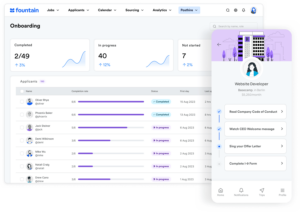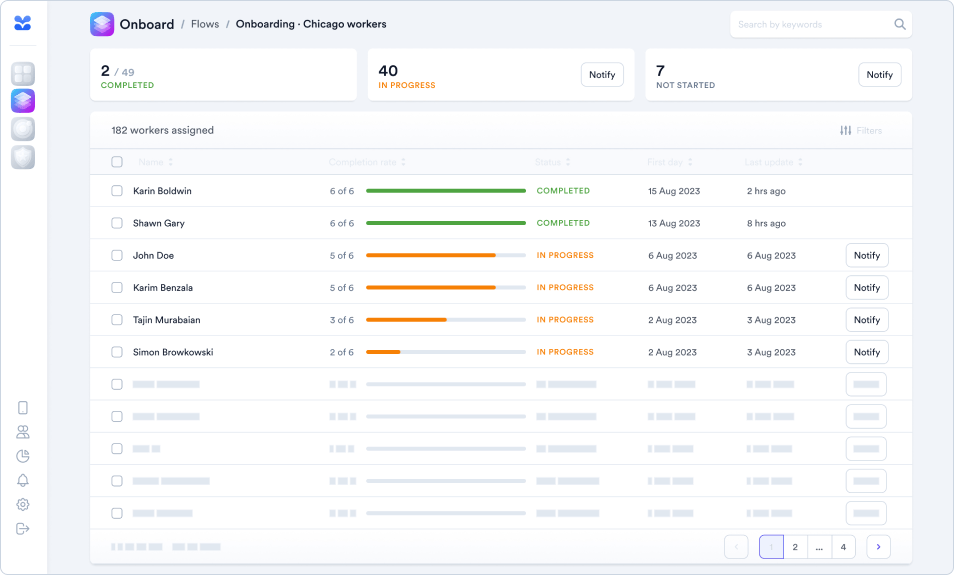In the world of talent acquisition, recruiting doesn’t stop the moment an offer is extended. Once hired, new workers need to enter a period of orientation and acclimation, usually managed by the recruiting team. The importance of employee onboarding cannot be overlooked, so it can be a tall order for recruitment teams of varying sizes and resources.
Your employee onboarding process can make or break your new hires’ opinions of you as a company and a workplace, and can have a direct result on retention rates. Therefore, your onboarding program needs to be engaging, informative, and attentive to your candidates’ needs and expectations.
Sound daunting? Don’t worry—we’re here to help you navigate the often choppy waters of onboarding with a few best practices and even our homegrown solution to all your onboarding woes!

The fundamentals of successful onboarding
First, let’s start with the basics. What exactly does the employee onboarding process entail?
- A well-defined strategy. Start with outlining what you want your onboarding process to achieve, including far-reaching goals like improved retention rates.
- Pre-hire activities and orientation. Make a list of pre-hire activities your workers need to complete, such as document signing, form submissions, ID badge distribution, etc.
- First-day activities. Arrange first-day logistics such as parking, transportation to the work site, ensuring they have access to their workspaces, etc.
- Training. Training doesn’t just take place during your new hire’s first day, week, or even month. It should be an ongoing initiative that keeps your workers’ skillsets fresh.
The pros of a top-notch employee onboarding strategy
The connection between an optimal onboarding process and employee satisfaction makes clear sense: When your workers feel prepared for their job, they’re more likely to do it well and face fewer obstacles to success. They’re also more likely to be engaged as an employee and therefore more dedicated to their duties and the company as a whole. This can have a direct effect on employee retention—happier employees tend to stay with their employer longer rather than jumping ship for a better opportunity elsewhere.
Increased retention and decreased turnover also have positive impacts on your company’s ROI. The less turnover you experience, the less of your budget you’ll need to devote to recruiting activities.
On the contrary, a poor onboarding experience can result in underprepared employees, poor performances, and disengaged workers, all of which can hinder company progress and growth.
Maximize your ROI with our latest guide: How to Do More with Less
The biggest obstacles to employee onboarding at scale
Speaking of growth, it’s most likely one of your organization’s main objectives so finding an onboarding solution that can scale as you grow is key.
But in the current talent acquisition landscape, not all onboarding solutions are built for such scalability. Some high volume employee onboarding processes still rely on manual involvement from recruiters, which slows down onboarding speed and delays the time it takes to get new hires into their new roles. This can lead to disengaged hires who may not even show up on their first day of work.

In the next sections, we’ll explore ways to improve whatever onboarding situation you’re facing—whether you’re a team of one or a team of 20—to help your get new hires ready for their first days of work faster.
Best practices for employee onboarding
Taking into account everything we’ve mentioned regarding the importance of a solid onboarding process, we’re sharing some best practices to keep in mind when building your ideal employee onboarding solution.
Start with a strategic plan
Gather your recruitment team and ensure everyone is aligned in terms of what tasks need to be part of onboarding, who is responsible for what, and what goals you want your onboarding process to accomplish in a given timeframe.
Follow a comprehensive onboarding checklist
Any decently organized plan involves a checklist—a visual representation of every task that needs to be completed. Create a checklist with your team and ensure everyone has access to the list, as well as visibility into updates and changes.
Centralize your workforce data and documentation
As your plans begin to materialize, keep track of all data and documentation in one central location. This will allow you to revisit it when it’s time to scale or when you feel the need to revamp your process based on changing personnel needs.
Keep new hires engaged
The employee communication doesn’t (and shouldn’t) stop once new hires accept their offers. Stay connected to them through emails and text messages to remind them of important upcoming dates or tasks they need to complete, and emphasize your excitement to have them on your team.
Focus on delivering a personalized experience
This communication shouldn’t be filled with blanket statements and generic messaging. Focus on making your messages more personal so that even if you’re hiring hundreds of people, your new hires will still feel that personal touch.
Leverage mobile-first tools
Make mobile-first messaging work for you: Give your employees the chance to do as much as possible from their phones. This presents fewer barriers to access (and the first day) than requiring them to complete manual, desktop-based tasks.

Track and measure success
The true test of a successful employee onboarding process can be viewed and analyzed through a solid reporting component. Use this information to make adjustments and improvements as you go, which will inform future planning and goals as you grow.
How a modern ATS can simplify employee onboarding at any scale
Eager to transform how you onboard? You’re in luck! Most of today’s hiring solutions can help you achieve whatever your onboarding goals may be.
Solutions that are built for high volume hiring come with plenty of automation opportunities that allow recruiters to communicate with candidates, share documents, and initiate steps of the process, all without needing recruiter involvement. This helps resolve issues like sluggish onboarding, poor communication with candidates, and misinformed and underprepared first-day employees.
Onboard with Fountain
One such solution is Fountain Onboard—a user-friendly, AI-driven, fully customizable platform that helps reduce drop-off rates. Fountain Onboard ensures every new hire starts their career journey with confidence, connection and readiness.
Our customers who have used Fountain Onboard have seen a 75% increase in administrator efficiency! So what are you waiting for? Click below to learn more.
See how Fountain Onboard can help you get new hires up to speed with ease.

